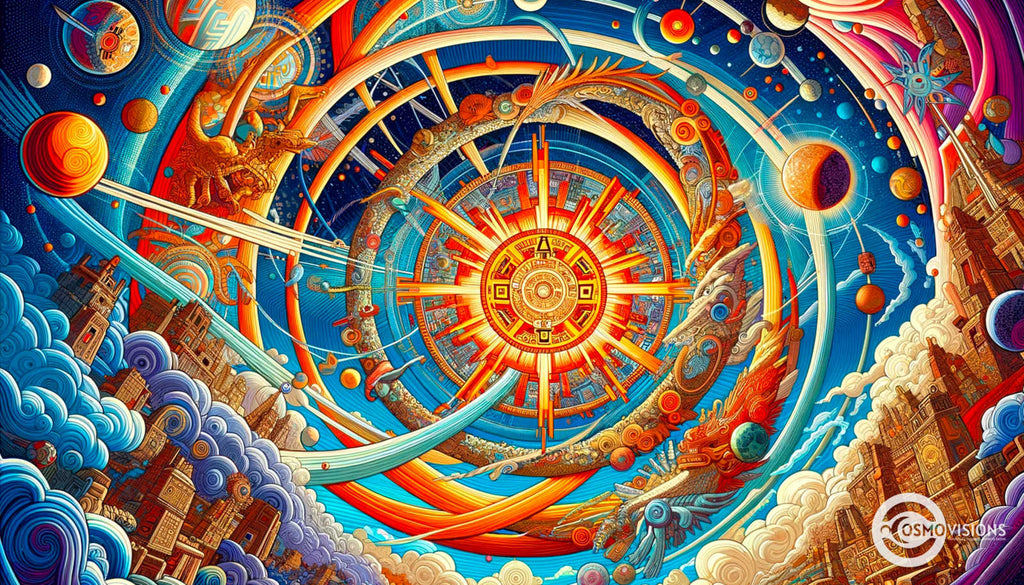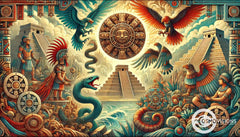Teotl and the Dance of Opposites: Aztec Insights into the Fabric of Reality
Posted by Massimiliano Geraci

Imagine a world where the very fabric of existence is woven from a dance between opposites, a perpetual oscillation that defies static definition. Welcome to the Aztec cosmos, where the concept of Nepantla serves as the metaphysical loom on which reality is intricately woven. Far from a mere philosophical abstraction, Nepantla is the Aztecs’ answer to the riddle of existence—a dynamic equilibrium that exists not in stasis but in constant flux.
In the Aztec worldview, Nepantla is not a fixed point but a fluid state, a ceaseless interplay between polar forces known as inamic pairs. Think of it as a cosmic pendulum, swinging eternally between opposites like light and dark, order and chaos. It’s not about finding a middle ground but embracing the tension, the eternal tug-of-war that animates the universe.
The Cosmic Loom: Inamic Pairs and the Symphony of Existence
If Nepantla is the loom, then Teotl, the primordial creative force, is the master weaver. In the Aztec metaphysical tapestry, Teotl orchestrates a delicate balance between inamic pairs—those polar opposites like fire and water, earth and sky, that exist in a state of dynamic tension. Picture a cosmic symphony where each instrument plays a vital role, and the conductor skillfully modulates the tempo to create a harmonious whole.
Through Nepantla, Teotl weaves this cosmic tapestry with the finesse of a virtuoso, integrating polarities like wet and dry, solid and airy, into a grand design. It’s as if Teotl is a jazz musician, improvising on a theme, constantly adjusting the balance between each pair to create a fluid, ever-changing melody. This is the art of Nepantla in action—a dynamic modulation that serves as the universe’s signature weaving technique.
The Infinite Fabric: Reality as the Art of Becoming
In the end, what emerges is a breathtaking vision of reality as an infinite, interconnected fabric, constantly textured and re-textured by the forces of Nepantla. It’s as if the universe itself is a grand “mega-loom,” its every thread interwoven with the essence of Teotl. Every phenomenon, every event, every moment is a manifestation of this eternal weave-in-progress.
In this grand schema, Nepantla is not just a concept but the very pulse of existence. It serves as the animating force, the textural undercurrent that drives the ever-evolving tapestry of reality. It’s the grain in the wood, the ripple in the water, the DNA of the cosmic architecture.
So the next time you find yourself caught between opposites, remember the Aztec wisdom of Nepantla. For in this ancient understanding, the tension between polarities is not a problem to be solved but a mystery to be lived—a dynamic dance that is the very heartbeat of the cosmos.

The Aztec Cosmos: Weaving the Fabric of Time and Space
The Fifth Sun-Earth Age: A Cosmic Loom in Motion
In the heart of Aztec mythology lies the concept of the Five Ages, with the present era known as the Fifth Sun-Earth Age. Imagine this age not as a mere chapter in a cosmic book but as a grand tapestry woven on an immense celestial loom. According to indigenous sources, this metaphysical loom is far from static; it’s a dynamic interplay of cosmic forces.
Picture the sun, known as 4 Olin Tonatiuh, as a weft shuttle, tirelessly weaving its path across the horizon, traversing realms both seen and unseen. This solar journey is not solitary; it’s intricately connected to the vertical warp threads formed by the Aztec calendars, particularly the tonalpohualli. As the sun weaves its path, it integrates these vertical and horizontal dimensions, creating a harmonious blend of the celestial and terrestrial, the above and below. It’s as if the sun itself is the conductor of a cosmic orchestra, bringing the disparate elements of the universe into a unified symphony.
The Primordial Tapestry: Nepantla and the First Four Ages
But what of the eras that came before this Fifth Age? Indigenous records offer a glimpse into these primordial times, markedly different in their cosmic architecture. Unlike the Fifth Age, these initial epochs lacked a sun-defined weft to mediate between dimensions. Yet, they needed more structure and meaning.
In these bygone ages, the cosmic forces of Quetzalcoatl and Tezcatlipoca took center stage. These deities, embodying creation and destruction, wove a tapestry of their own through the dynamic concept of Nepantla. Over successive cycles, their alternating spells of creation and annihilation generated a holistic, interconnected fabric. Only in the Fifth Age's emergence did these cosmic forces unite, crafting an era defined by intrinsic Nepantla balance, where the sun’s weft brought all realms into harmonious alignment.
The Pluriverse: A Loom of Infinite Dimensions
To truly grasp the Aztec vision of the cosmos, one must envision it as a multidimensional loom. Above this loom are thirteen layers of sky, while nine subterranean realms lie below. The variegated tapestry of earthly and heavenly worlds is suspended between these extremes, serving as the central warp panel.
In this complex weave, movable heddles and shed rods organize the intersectional topographies, creating a celestial span that defies simplistic categorization. Through this intricate framework, the Aztecs understood Teotl as perpetually interweaving an infinity of realms into a unified, multidimensional tapestry. Nepantla serves as the cosmic thread, weaving the warps and wefts of the Fifth Age into a grand, interconnected fabric of existence.
So, the next time you look up at the sky or ponder the mysteries of existence, consider the Aztec perspective. In their eyes, the universe is not a chaotic abyss but a meticulously woven tapestry; each thread imbued with purpose, each weave a testament to the intricate balance that sustains all life. It’s a cosmic dance of forces, a celestial loom that weaves the very fabric of time and space.
The Aztec Tapestry: Weaving the Fabric of Reality and Culture
The Social and Sacred Threads: Weaving in Aztec Life
In the heart of Aztec civilization, weaving was more than a craft; it was a social and spiritual tapestry that bound the community together. Elite women, masters of the loom, spun luxurious cloaks of cotton and maguey fiber, not just as garments but as symbols of power and divinity, worn by rulers and warriors alike. These intricately woven textiles also served as tributes, extracted like precious gems from conquered cities.
Imagine sacred cloths known as tlaquimilolli, laden with relics and offerings, connecting nobles to their patron deities as if by a celestial thread. Rulers would don sumptuous woven headdresses and mantles, each thread a testament to their divine authority. But it wasn’t just the elite; even ordinary citizens wore their life stories in the woven mats, skirts, and loincloths that adorned them. From these textiles, one could read the wearer’s gender, class, occupation, and marital status. And when life came to an end, individuals were buried with their mecamaxalli, the divided weaving strap used on backstrap looms, as if to carry the art of weaving into the afterlife.
The Economic and Spiritual Warp and Weft
Beyond the personal and political, woven textiles were the currency of life and faith. Luxury textiles were as valuable as gold in Aztec marketplaces, and the empire amassed wealth through tributes of woven cloth, with some regions obligated to provide over a staggering 100,000 woven pieces annually. But the fabric of Aztec society was not just material; it was spiritual. Both commoners and elites used finely crafted woven cloths in religious rituals, burning them as offerings or knotting them into sacred bundles. The very act of weaving extended into daily professions, from cotton farming to dyeing, underlining how the textile arts were not just a craft but a way of life.
The Cosmic Loom: Weaving as a Metaphysical Paradigm
The Aztecs saw the world through the lens of weaving, applying its metaphors to everything from architecture to medicine. Picture homes and temples designed to emulate the structure of a loom, their roofs and walls woven together from reed poles, thatch, and adobe. Medical treatises described the human body as a tapestry of fibers and vessels, intricately woven together to form the essence of life.
In religious rituals and divination, the patterns left by maize kernels or incense smoke were seen as the creative interlacings of the cosmos. Time was envisioned as a series of colored warp stripes, interwoven by the solar weft, with celestial and underworld spheres serving as the loom’s warp threads.

Teotl: The Master Weaver of Reality
At the core of this intricate worldview was Teotl, the metaphysical totality, seen as the supreme weaver of the universe. Through the dynamic concept of Nepantla, Teotl wove the fabric of existence, balancing polar forces in an eternal dance of creation and destruction. Every god, every mortal, every phenomenon was a thread in this cosmic tapestry, interdependent and interconnected.
For the Aztecs, life itself was an act of weaving, a participation in the ongoing creation of the universe. To live was to weave oneself into the cosmic pattern, to become a part of the eternal tapestry that is ever in the making. It was not just about existing but about contributing to the grand design, just as Teotl does, in an endless cycle of weaving being into being.
So, the next time you look at a piece of woven fabric, consider the Aztec perspective. For them, each thread was a story, each pattern a philosophy, and each textile a universe in itself, woven not just by human hands but by the very forces that shape reality.






















